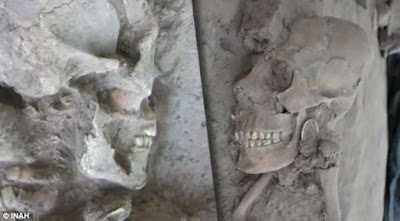 Three drawings that show's Art View the methods that were used by Maya peoples to shape their child's head into a oblong egg type shape. Head pressed children were found in archaeological grave dig however, archaeologist as Cristina Garcia Moreno continued to explain to Art View, 'In this case, you cannot recognize any social differences because all the burials seem to have the same characteristics. 'Nor have we been able to determine why some were wearing ornaments and others were not, or why of the 25 skeletons only one was a female. The team say the number of infants and pre-pubescents could show the high risks involved in the cranial deformation to occur at a very young age, this can kill from the excessive force been applied squeezing the skull hence their are so many children buried. The find has been dated to the year 943 CE from samples taken from one of the individuals. This burial ground contained 25 individuals, and 13 of them have what researchers describe as 'intentional cranial deformation'.
Three drawings that show's Art View the methods that were used by Maya peoples to shape their child's head into a oblong egg type shape. Head pressed children were found in archaeological grave dig however, archaeologist as Cristina Garcia Moreno continued to explain to Art View, 'In this case, you cannot recognize any social differences because all the burials seem to have the same characteristics. 'Nor have we been able to determine why some were wearing ornaments and others were not, or why of the 25 skeletons only one was a female. The team say the number of infants and pre-pubescents could show the high risks involved in the cranial deformation to occur at a very young age, this can kill from the excessive force been applied squeezing the skull hence their are so many children buried. The find has been dated to the year 943 CE from samples taken from one of the individuals. This burial ground contained 25 individuals, and 13 of them have what researchers describe as 'intentional cranial deformation'.  Painting by Paul Kane, showing a 'Chinookan Child' in the process of having its head flattened, and an adult after the process. Also known as head binding or head flattening, the practice was usually done to signify group affiliation or as a way to demonstrate social status but still has some significant s towards defining aristocratic shape in today's form. The earliest written record of cranial deformation dates to 400 BC in Hippocrates' description of the Macrocephali or Long-heads, although it is believed the Neanderthals may also have used the technique.It was typically carried out on infants as their skulls could be easily molded To create the effect, wooden boards were applied to the skull with pressure, typically starting at the age of about one month, and then for the next six months. However, the method was extremely risky, and in the latest find, researchers believe the fact many of those with disfigured skulls died young show just how dangerous it was if you see.
Painting by Paul Kane, showing a 'Chinookan Child' in the process of having its head flattened, and an adult after the process. Also known as head binding or head flattening, the practice was usually done to signify group affiliation or as a way to demonstrate social status but still has some significant s towards defining aristocratic shape in today's form. The earliest written record of cranial deformation dates to 400 BC in Hippocrates' description of the Macrocephali or Long-heads, although it is believed the Neanderthals may also have used the technique.It was typically carried out on infants as their skulls could be easily molded To create the effect, wooden boards were applied to the skull with pressure, typically starting at the age of about one month, and then for the next six months. However, the method was extremely risky, and in the latest find, researchers believe the fact many of those with disfigured skulls died young show just how dangerous it was if you see. Cranial deformation in Mesoamerican cultures, The find is eerily similar to the ‘Alien in Ridley Scott's film’ of the same name. One of the 13 individuals with cranial deformation discovered in the cemetery in Mexico had this completed metamorphic type feature. It is an astonishing image that could have come straight from the plot of a Ridley Scott movie. Archaeologists in Mexico today revealed the astonishing skull of a person suffering from a cranial transfiguration Find is new evidence of cranial deformation, where skulls were tightly bound in wooden supports to alter their shape. These unique head shape was used to differentiate different social classes. Believed to be 1,000 years old, the find was made near the small Mexican village of Onavas.
Cranial deformation in Mesoamerican cultures, The find is eerily similar to the ‘Alien in Ridley Scott's film’ of the same name. One of the 13 individuals with cranial deformation discovered in the cemetery in Mexico had this completed metamorphic type feature. It is an astonishing image that could have come straight from the plot of a Ridley Scott movie. Archaeologists in Mexico today revealed the astonishing skull of a person suffering from a cranial transfiguration Find is new evidence of cranial deformation, where skulls were tightly bound in wooden supports to alter their shape. These unique head shape was used to differentiate different social classes. Believed to be 1,000 years old, the find was made near the small Mexican village of Onavas.  The find is believed to be the first in the region showing the practice of binding a skull to change its shape this was used to differentiate one social group from another and for ritual purposes.' said archaeologist Cristina Garcia Moreno, director of the research project. 'This is confirmed by the findings at the Sonora cemetery where the five bodies with dental mutilation are all over 12 years in age.' Believed to be 1,000 years old, the find was made near the small Mexican 'village of Onava'.
The find is believed to be the first in the region showing the practice of binding a skull to change its shape this was used to differentiate one social group from another and for ritual purposes.' said archaeologist Cristina Garcia Moreno, director of the research project. 'This is confirmed by the findings at the Sonora cemetery where the five bodies with dental mutilation are all over 12 years in age.' Believed to be 1,000 years old, the find was made near the small Mexican 'village of Onava'. The burial ground consists of 25 individuals; 13 have intentional cranial deformation and five also have dental mutilation. 'This unique find shows a mix of traditions from different groups of northern Mexico,' said Moreno. The use of ornaments made from sea shells from the Gulf of California had never been found before in Sonoran territory and this discovery extends the limit of influence of Mesoamerican peoples farther north than has been previously recorded,” she said in a video posted to YouTube.
The burial ground consists of 25 individuals; 13 have intentional cranial deformation and five also have dental mutilation. 'This unique find shows a mix of traditions from different groups of northern Mexico,' said Moreno. The use of ornaments made from sea shells from the Gulf of California had never been found before in Sonoran territory and this discovery extends the limit of influence of Mesoamerican peoples farther north than has been previously recorded,” she said in a video posted to YouTube.  Some of the individuals were wearing ornaments such as as bangles, nose rings, earrings, pendants made from shells found in the Gulf of California, and one burial contained a turtle shell, carefully placed over the abdomen, according to Dental disfigurements were also found is several of the skulls, which was believed to be a rite of passage. Garcia Moreno has been conducting work on behalf of Arizona State University with approval of the National Institute of Anthropology and History (INAH).The dental mutilations discovered are believed to be a rite of passage. 'The dental mutilation in cultures such as the Nayarit was seen as a rite of passage into adolescence,' said Moreno.
Some of the individuals were wearing ornaments such as as bangles, nose rings, earrings, pendants made from shells found in the Gulf of California, and one burial contained a turtle shell, carefully placed over the abdomen, according to Dental disfigurements were also found is several of the skulls, which was believed to be a rite of passage. Garcia Moreno has been conducting work on behalf of Arizona State University with approval of the National Institute of Anthropology and History (INAH).The dental mutilations discovered are believed to be a rite of passage. 'The dental mutilation in cultures such as the Nayarit was seen as a rite of passage into adolescence,' said Moreno.






No comments:
Post a Comment